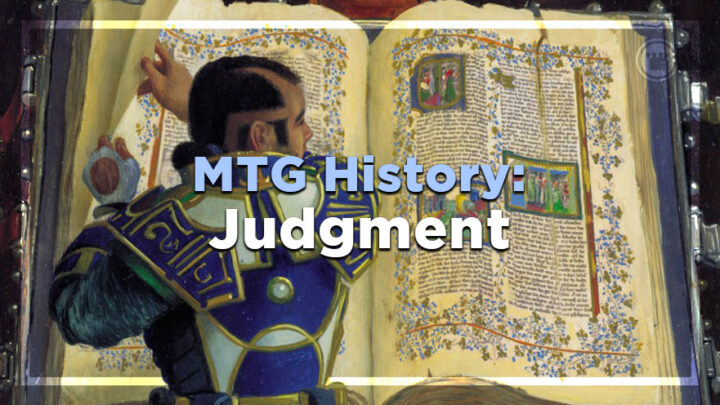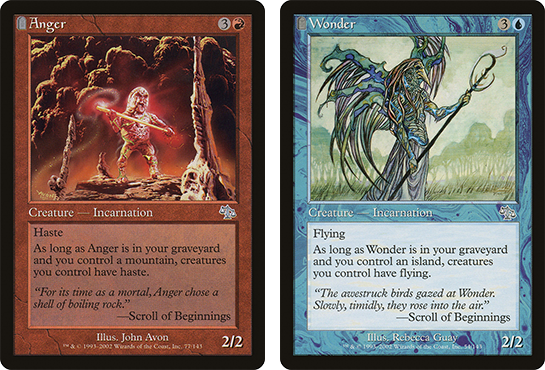Nizzahon looks at a significant event on this day in MTG history. On May 27th, 2002, Judgment was released!
Welcome to another edition of “On This Date in Magic History.” This week, we’re going to take a look at the release of Judgment, which came out on May 27th, 2002. It was the third and final set in Odyssey Block, coming after Odyssey (October 1st, 2001) and Torment (February 8th, 2002). It wasn’t just any old set though. There are a number of things about Judgment that make it a particularly notable set in Magic’s long history. There are also several cards from the set that have gone on to be fixtures in multiple formats!
Judgment is All About Green and White
For one thing, the set has a pretty unusual gimmick – it is really focused on Green and White cards. I think a look at the breakdown of cards in the set is really the best way to convey how unusual this is. The set has 143 cards in it. 33 of them are mono-White, 33 are mono-Green, 16 are Black, 27 are Red, and 27 are Blue. The set also has three lands and four multicolored cards – and all of them are for Green/White decks. The previous set, Torment, was focused on Black, and it minimized Green and White cards, so Judgment was really correcting for this imbalance. I don’t think it is entirely impossible that we see another set that has more of a focus on a particular color. After all, we see sets that are focused on particular color pairs – like Strixhaven – so it isn’t a huge leap to think it could happen again.

The four multicolored cards from Judgment
Judgment Was The First Set To Simultaneously Release on Magic Online
In addition to having a unique gimmick, Judgment is also notable for being the first new set to receive a simultaneous release on Magic Online. In May of 2002, Magic Online was nearing the end of its beta-testing period, so it was a good time to test putting brand new cards on the client right when they were released. Unfortunately, it didn’t go very well! A mistake was made by the Magic Online team, and the entire set became available to Magic Online beta testers before the set was released. Basically, the entire set was accidentally leaked.
This mistake had a long-term impact on how sets would be released on Magic Online for the next decade and a half. In order to avoid another accidental leak, Wizards of the Coast decided to release sets on Magic Online one to two weeks after they became available in paper. That way, if someone messed up again, it wouldn’t be such a big problem because the set was already available! This strategy would stick around on Magic Online all the way until the release of Amonkhet in April of 2017, the first time a set was released in paper and on MTGO at the same time. These days, the paper release and online release are usually simultaneous.
The Prerelease Promo
The set also featured a very unique pre-release promo: a Hebrew-language version of Glory.
This was actually the sixth consecutive set with a promo featuring a foreign language, as every set in both Invasion Block and Odyssey Block featured one. The previous sets had used Latin, Greek, Sanskrit, Arabic, and Russian. As a Jew who studies Jewish history, the Hebrew Glory is personally one of my favorite cards in the entire game and one of my most-prized Magic possessions! If you ever watch my videos on YouTube, you’ve probably seen the card in a frame behind me. This whole series of promo cards was really cool, and it would be neat to see it again! And I mean in a real language – not Phyrexian.
Notable Cards from Judgment
There are many cards from Judgment that have seen competitive play, like the ferocious Phantom Nishoba. However, in the long term, the Wish and Incarnation cycles have far and away been the most important cards in the set.
Wishes
Way back in 1993’s Arabian Nights, a card called Ring of Ma’ruf did something really strange – It allowed you to put a card you own from outside of the game into your hand! This mechanic disappeared between 1993 and 2002, before emerging again in Judgment, and it appeared on multiple cards! This set featured a cycle of five cards with “wish” in their name. They each allowed you to take a card you owned from outside the game and put it directly into your hand. Obviously, if these cards worked exactly how they were worded this would be a pretty big nightmare to regulate in competitive Magic. At sanctioned tournaments, this just means that you can grab a card from outside of your sideboard, but that’s still very powerful. This really changed deckbuilding, at least in decks taking advantage of Wish effects. This allows you to turn your entire sideboard into a toolbox. Sometimes when you cast a wish you want to grab a situational card that is excellent in a certain match-up. This allows you to take advantage of your sideboard cards even in game one of a match, which is pretty nice!
Wishes are used the most frequently in combo decks, since you can use wishes to fetch additional copies of combo pieces. For example, storm decks in the Eternal formats often win with Tendrils of Agony. Typically, these decks include one copy of the card in the main deck and another in the sideboard which can be fetched by Burning Wish. This effectively makes every copy of Burning Wish in the deck into additional copies of Tendrils of Agony.
In the two decades since the release of Judgment, several other cards have been printed with effects that allow a player to get cards out of their sideboard, and they have been key cards in many competitive decks. The two most notable examples of this are Fae of Wishes and Karn, the Great Creator. So, not only did the original cycle of Wishes find a lot of competitive success on its own, they also set the stage for future cards with similar effects. To this day, players often refer to this type of effect as a “Wish” as a result of this cycle of cards from Judgment.
If you want a deeper dive on the subject of Wishes, check out my MTG Top 10 on the subject!
Incarnations
“Incarnation” was a creature type that was introduced in Judgment. All of these creatures gave you some effect while they were in your graveyard. Each color got an Uncommon, and – in keeping with the set’s focus on Green and White – White also received a Rare incarnation. The same Glory that received a Hebrew language promo card!
However, the two of these Incarnations that have had the most longevity are Anger and Wonder. Anger gives your creatures Haste, while Wonder gives them Flying. Both of these are heavily used in creature-based graveyard decks in the Eternal formats. Because these decks already mill themselves and/or discard cards, it isn’t hard for the Incarnations to end up in the graveyard. Anger allows the deck to swing right away with reanimated creatures, and Wonder helps your creatures get in through the air. Giving your Hogaak, Arisen Necropolis one of these keywords is pretty spicy!
If you want to know even more about Incarnations, check out my MTG Top 10 that covers this interesting creature type.
Parting Words
For a set with only 143 cards, Judgment has had an outsized impact on Magic. This set gave us “Wish” effects and Incarnations which have been regularly played for two decades. It also set the precedent of releasing Magic digitally, and it had a fascinating Green-White gimmick. Doing a retrospective on a set like this really makes me wonder how more recent sets will be looked at. Is there anything in Streets of New Capenna that might have the longevity of the Wishes or Incarnations in Judgment? I guess we’ll take a look in 20 years!
Thanks for reading, and I’ll be back next week with a look at another important event in Magic history!

Jacob has been playing Magic for the better part of 24 years, and he especially loves playing Magic’s Limited formats. He also holds a PhD in history from the University of Oklahoma. In 2015, he started his YouTube channel, “Nizzahon Magic,” where he combines his interests with many videos covering Magic’s competitive history. When he’s not playing Magic or making Magic content, he can be found teaching college-level history courses or caring for a menagerie of pets with his wife.







